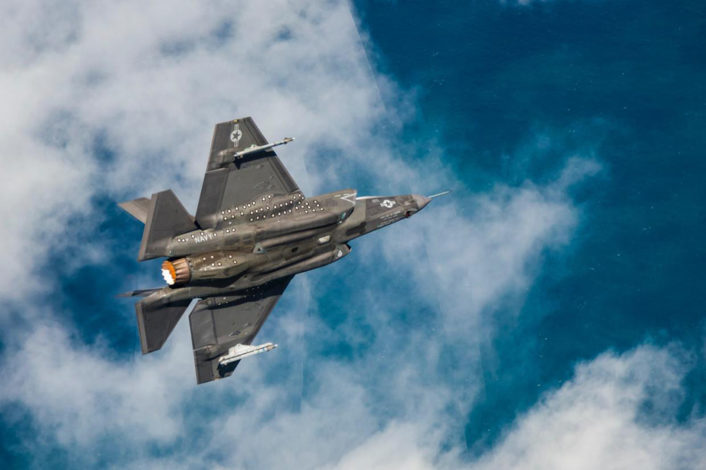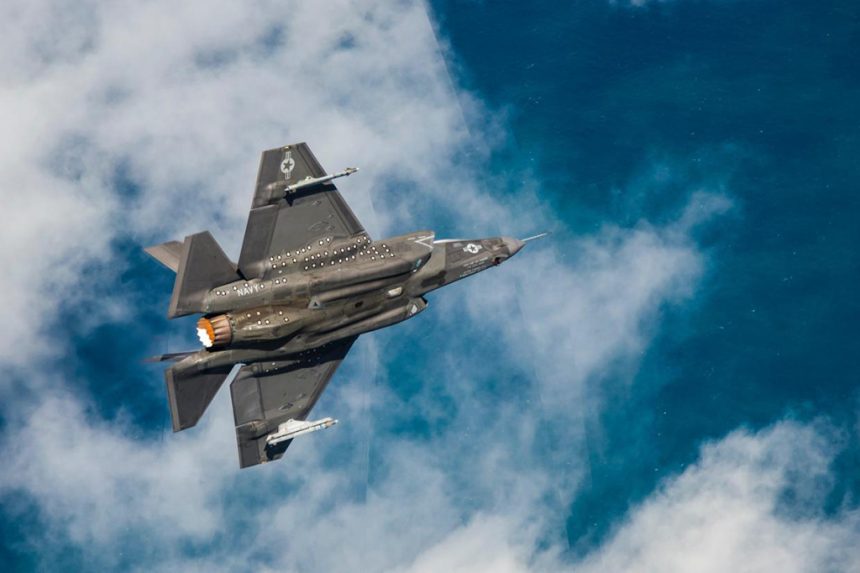The photograph was taken in the exact moment when the pilot transitioned from subsonic to supersonic speed.
The photograph in this post shows a U.S. Navy Lockheed Martin F-35C Lightning II of Air Test and Evaluation Squadron 23 (VX-23) “Salty Dogs” during a test flight. Released by the Naval Air Warfare Center Aircraft Division, the image was taken as the stealth aircraft, carrying external AIM-9X Sidewinder AAMs (Air-to-Air Missiles), flies transonic: indeed, what makes the shot particularly interesting are the schlieren shock waves that flight test photographers captured as the JSF transitioned from sub-sonic to supersonic.
Schlieren imagery is a modern version of a 150-year-old German photography technique, used to visualize supersonic flow phenomena: a clear understanding of the location and strength of shock waves is essential for determining aerodynamic performance of aircraft flying at supersonic speed in different configurations, for improving performance as well as designing future jets.
“Schlieren imaging reveals shock waves due to air density gradient and the accompanying change in refractive index,” says the NASA website that published an extensive article about this particular kind of photography few years ago. “This typically requires the use of fairly complex optics and a bright light source, and until recently most of the available schlieren imagery of airplanes was obtained from scale model testing in wind tunnels. Acquiring schlieren images of an aircraft in flight is much more challenging. Ground-based systems, using the sun as a light source, have produced good results but because of the distances involved did not have the desired spatial resolution to resolve small-scale shock structures near the aircraft.”

Noteworthy, while schlieren imaging dramatically displays the shock wave of a supersonic jet (image processing software removes the background then combines multiple frames to produce a clear picture of the shock waves as shown here and here) change in refractive index caused by shock waves can also become visible when aircraft move at speed much lowen than transonic, as shown in photographs taken last year. Here what I wrote last year about a crazy cool image of an F-35 flying through the famous Star Wars canyon taken by photographer Jim Mumaw:
At speed lower than the transonic region, air flows smoothly around the airframe; in the transonic region, airflow begins to reach the speed of sound in localized areas on the aircraft, including the upper surface of the wing and the fuselage: shock waves, generated by pressure gradient resulting from the formation of supersonic flow regions, represent the location where the air moving at supersonic speed transitions to subsonic. When the density of the air changes (in this case as a consequence of shock waves) there is a change in its refractive index, resulting in light distortion.
Generally speaking, shock waves are generated by the interaction of two bodies of gas at different pressure, with a shock wave propagating into the lower pressure gas and an expansion wave propagating into the higher pressure gas: while the pressure gradient is significant in the transonic region, an aircraft maneuvering at high-speed through the air also creates a pressure gradient that generates shock waves at speed much lower than the speed of sound.









